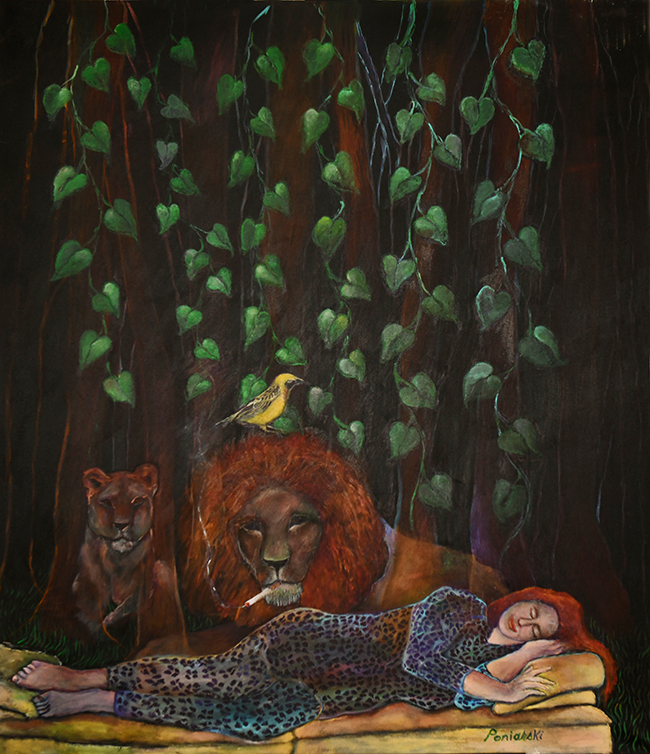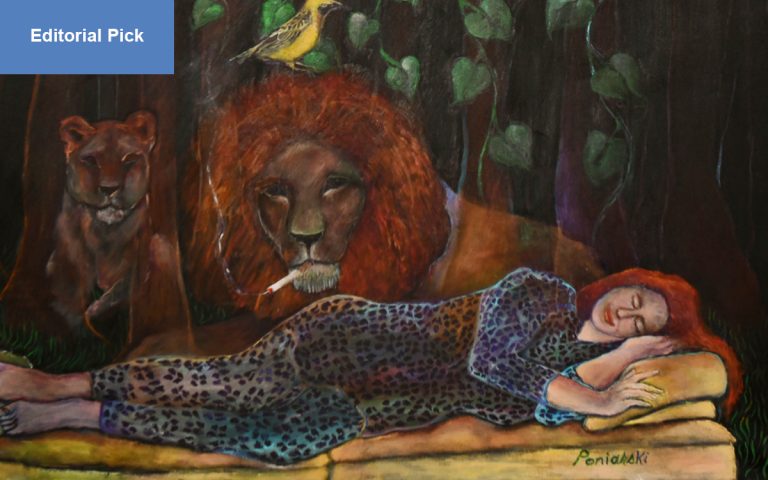Ruth Poniarski didn’t begin her creative life with a paintbrush. She started with blueprints and drafting tools, earning her Bachelor of Architecture from Pratt Institute in 1982. For the next ten years, she worked in construction—building structures with logic, measurements, and hard edges. But in 1988, she turned to painting, a medium that allowed for less rigidity and more emotional and intellectual freedom. Painting gave her a way to channel her thoughts, questions, and stories onto canvas in ways that architecture could not. Her work draws from myth, literature, culture, and philosophy. Each painting carries a surreal quality, often dreamlike or symbolic. Through her art, Poniarski creates a space where thought, history, and narrative intertwine. She’s not trying to represent the visible world, but rather to give shape to the internal one—one built from the strange, the remembered, the imagined.

Curtain of Leaves
In Curtain of Leaves, Ruth Poniarski invites us into a scene that feels both timeless and suspended—like a dream unfolding at dusk. A lioness lies in repose, seemingly undisturbed, as wind stirs the canopy above. This is not a wildlife scene, though. It’s a symbolic tableau, part vision, part meditation.
The yellow horizon behind the lioness sets a stage that suggests both peace and caution. Yellow is often a color of vitality or attention. It may point to the beginning or end of a day—or even a life. The lioness, usually a symbol of strength and guardianship, is shown here as slumbering. But her presence remains commanding. She is not absent—just resting, as if biding her time. Her mate, meanwhile, is described as basking in nostalgia. This moment of quiet, and possibly of mourning or reflection, is steeped in layers of smoke, breath, and memory.
The phrase “the air brimming with whispers of redolence” sets the tone for the entire painting. It gives the canvas a scent, a texture, and a sound. There’s something fragrant in the atmosphere, though we don’t know what exactly it is. It could be the forest. It could be a memory. It could be her territory. The ambiguity is intentional. Poniarski often leans on sensory language to create immersion, not direction.
The lioness becomes a feminine form of tranquility. She embodies a kind of still power. She isn’t passive—she’s present, aware, and part of a much older narrative. She awakens to her role not in isolation, but as part of a shared realm—a kingdom beneath a curtain of leaves.
That phrase—curtain of leaves—is more than the title. It’s the veil through which the viewer peers into the scene. It might be a literal visual element: a forest canopy, vines, or branches framing the figures. But it also works metaphorically. The leaves may stand for time, memory, or experience. They filter the light, soften the details, and create a space that is part-real, part-symbol.
There’s a gentle dualism in this painting. Darkness and light are both present. So are motion and stillness. The lioness slumbers while the wind stirs. Her mate is awake, but not active—just remembering. There’s smoke, but no fire. Time is felt, not shown. Everything seems to hold its breath, suspended in a kind of sacred hush.
Poniarski isn’t offering a clear story here. Instead, she’s crafting a space where the viewer brings their own. Is this about loss? A return? A kind of natural rite? Possibly. But the lack of a defined narrative is part of its appeal. It asks us to sit with it, not solve it.
As with much of her work, Curtain of Leaves taps into myth without referencing a specific one. There’s something ancient about it. The forest could be African, European, or purely imagined. The lioness could be a goddess or a memory. The painting holds enough to suggest meaning but leaves enough unsaid to encourage interpretation.
What’s clear is that Ruth Poniarski sees the world—and its metaphors—as layered and intertwined. She paints not just with acrylics, but with language, atmosphere, and symbol. Curtain of Leaves is quiet, but not soft. It hums with tension, story, and presence. And in that space between realism and surrealism, she offers us a glimpse of something familiar—just under the surface, behind the leaves.

